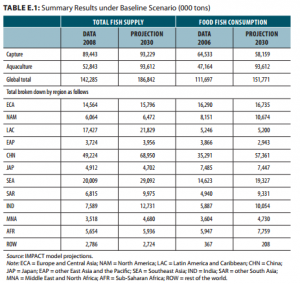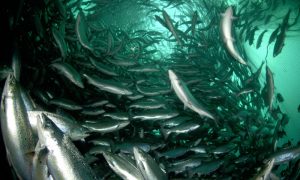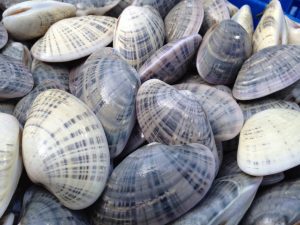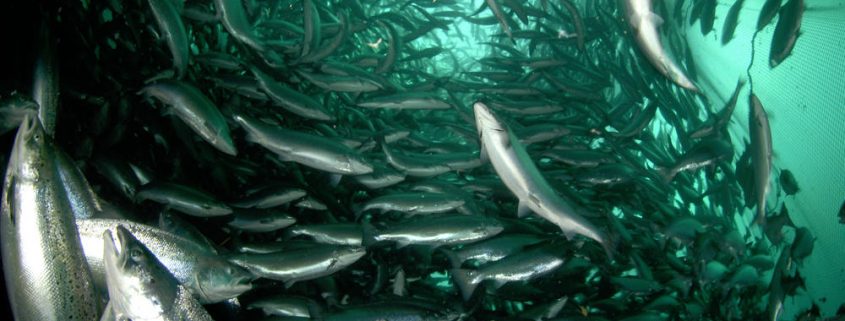An introduction to aquaculture
By William Evans, SRC Intern
When most people think about aquaculture, commonly known as fish farming, they automatically assume that it is the culturing of the different types of fish that we commonly see in our local supermarkets like salmon and tilapia. In 2008, only 37% of the total global fish supply was provided by aquaculture and by 2030, aquaculture is projected to supply over 50% of the world’s total fish supply (Kobayashi, 2015). Despite aquaculture’s increasing demand, there are still negative associations that coincide with the industry. Increasing consumer awareness of the product source and safety can negate many of these misconceived notions. There are resources like the Monterey Bay Aquarium Seafood Watch Program that recommends what food is safe to eat in a specific state and the sustainability of that industry.

This table displays data taken in 2008 and the projected data for capture fisheries versus aquaculture in 2030. (Source: Fish to 2030)
Because a majority of our fishing practices are unsustainable because of actions such as longlining and bottom trolling, we are depleting our global fisheries. Aquaculture is gradually being used to fill the void where wild caught fisheries once were. Although a large portion of aquaculture is still used for food production, there are other uses for aquatic farming. Some examples include stock enhancement, research, ornamental fish production for aquarium trade, as well as supporting the production of pharmaceutical, biotechnology, and nutritional products (What is Aquaculture, 2015) . Aquaculture’s effect on biotechnology can help improve the conservation and management of wild stocks by providing useful information about the fish species such as fish health and growth rate (Bartley, 2005). Biotechnology in aquaculture also assists in increasing the nutritional value of fish feeds, increase the growth rates and productivity of cultured species, and help protect environments by increasing the sustainability of aquaculture (Bartley, 2005).

This photo from the World Wildlife Fund shows the amount of salmon that can be cultured in a smaller area. They also state that it only takes between 1.3 to 1.7 pounds of feed to produce one pound of salmon, in comparison to the 10 to 12 pounds of feed to make one pound of beef. (Source: http://www.worldwildlife.org/industries/farmed-salmon)
The feeds used in aquaculture are usually composed of fishmeal and fish oil, which is not a sustainable part of the industry. Currently there are efforts to use vegetable products or terrestrial animals, like chickens, in some aquaculture feeds. The Soy-In-Aquaculture Managed Research Program is researching to determine the chemical amount found in soybean meal that can be then used in feeds for aquaculture. At the Aquaculture Investment Workshop 2015, which was hosted at the University of Miami, the U.S. Soybean Expert Council stated that soy production in the U.S. has increased 1.5 times per year and “US farmers will continue to respond to [the] demand,” says USSEC CEO, Jim Sutter (Nadkarni, 2015). This desire for the use of soy reflects on the need to conserve aquatic ecosystems and increase the sustainability of this industry.
As stated before, aquaculture and marine conservation are combined through stock enhancement strategies and restocking. Stock enhancement is adding individuals to a healthy population and restocking is adding individuals to depleted populations. Usually these strategies consist of releasing farm -raised juveniles into the wild for populations that are overfished or threatened by habitat loss and ocean acidification (Stock Enhacement, 2015). This process is strategic as to what point in the lifecycle the species should be released into the wild, where specifically they should be released and the timing, and the dynamics of the ecosystem. Currently, NOAA is working with partners for stock enhancement for a variety of species such as black abalone, blue crab, oysters, queen conch, spotted seatrout, winter flounder, and many more. By providing support to these species that are at risk due to an array of pressures, aquaculture can help alleviate some of the pressures on the wild stocks.
Many universities and research and development companies also focus on other topics aside from food production. For example, at the University of Miami, although some research and development is focused on biotechnology and increasing the yield of certain species, there are other studies concerned with bioenergetics, nutrition, developing proper protocols for shipping of various species, and many more. In October, Professor Bruce Barber received an $83,000 from the Aquaculture Resource Council to fund his research in the state of Florida to advance aquaculture for shellfish, tilapia, shrimp, and even alligator (Cotton, 2015). Because he believes that the Sunray Venus clam could potentially be the “next big aquaculture crop” for the state of Florida, he is focusing most of his research around this unexploited food source (Cotton 2015). Research like Barber’s can potentially change the market as to what consumers actually eat and can help protect the wild clam stocks in this region. Most of the public does not know that aquaculture can be used for restocking, stock enhancement, and even to do further research on wild aquatic species. Educating the public about topics that illustrate an intersection between aquaculture and marine conservation can change some of the negative associations with aquaculture. Consumer awareness and education through outreach and informal education about topics like aquaculture can change the mindset of the public to being more conscious of the benefits of such a controversial field.

Sunray Venus Clams: The Sunray Venus clam, the focus of Barber’s research, is potentially Florida’s upcoming, large aquaculture crop (http://cutthroatclams.com/hello-world/)
Sources:
Cottton, Emma. “Professor Bruce Barber receives grant for aquaculture research.” The Current. 26 October 2015. Web. < http://theonlinecurrent.com/professor-bruce-barber-receives-grant-for-aquaculture-research/>
Fisheries and Aquaculture topics. Biotechnology. Topics Fact Sheets. Text by Devin Bartley and Rohana Subasinghe. In: FAO Fisheries and Aquaculture Department [online]. Rome. Updated 27 May 2005.
Kobayashi, Mimako, et al. “Fish to 2030: The Role and Opportunity for Aquaculture.” Aquaculture Economics & Management (2015): 282-300. Print.
Nadkarni, Avani. “Aquaculture Investment Workshop 2015 blog: Recap on all the news here.” Intrafish. 05 April 2015. Web. 15 Nov 2015. <http://www.intrafish.com/free_news/article1411080.ece>
“Aquaculture for Stock Enhancement.” Aquaculture. National Oceanic and Atmospheric Association, n.d. Web. 12 Nov 2015. < http://www.nmfs.noaa.gov/aquaculture/science/11_stock_enhancement.html>.
“What is Aquaculture.” National Oceanic and Atmospheric Association, n.d. Web. 12 Nov 2015.< http://www.nmfs.noaa.gov/aquaculture/what_is_aquaculture.html>.




Leave a Reply
Want to join the discussion?Feel free to contribute!